The 7 Beautiful Great Dane Colors – With Pictures!
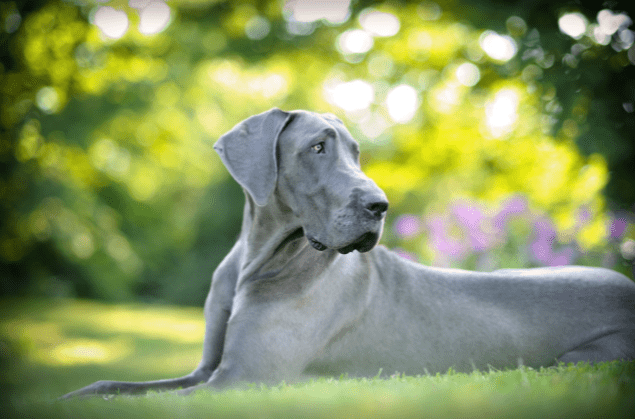
You’re not going to miss a Great Dane if you see one on the street. That’s for sure. These enormous pups are regal, cool, and a bit imposing. They’re also cuddly gentle giants.
Their soft nature, wonderful temperament, and patience around children make them popular family pets. But not only are these iconic dogs large and elegant, but they also come in a number of different coat colors and patterns.
So, how many Great Dane colors are there? What do the kennel clubs say? Find out all about these amazing dogs and their beautiful coats!
How Important is Color?
Everyone has a personal taste – and that’s totally fine. But color isn’t the first thing you should be thinking about when you adopt a pup. Especially not a Great Dane.
These dogs might be gentle, but they’re really big and you need to think about whether you have the experience and a lifestyle that could accommodate such a large canine.
Because of their size, they’re likely to accidentally knock things over. They may love kids, but their size can be problematic around small children.
The health of a dog is much more important than its coat color. Breeders should be breeding pups for good temperaments and health – not the color.
Great Danes can suffer from a number of health concerns associated with their size. Unethical breeding only makes these worse and the dogs suffer.
Always ensure that a breeder can give you all the required health documentation to ensure the parents of your pup were tested. This is particularly important if you want to adopt a merle Great Dane or a white Great Dane.
Merle dogs need to be single merles as doubles can suffer from eye and ear problems. White Great Danes can also suffer from many illnesses including deafness and blindness.
What Are The Official Great Dane Colors According to The American Kennel Club?
If you want to enter your Great Dane into a competition, you need to make sure they’re one of the standard Great Dane colors as listed by the AKC (or the governing kennel club).
The AKC recognizes the following colors:
- Black
- Blue
- Brindle
- Fawn
- Harlequin
- Merle
- Mantle
They also accept black and white markings and a black mask.
All The Amazing Great Dane Colors
Here’s an in-depth look at all the wonderful Great Dane colors.
Black Great Dane
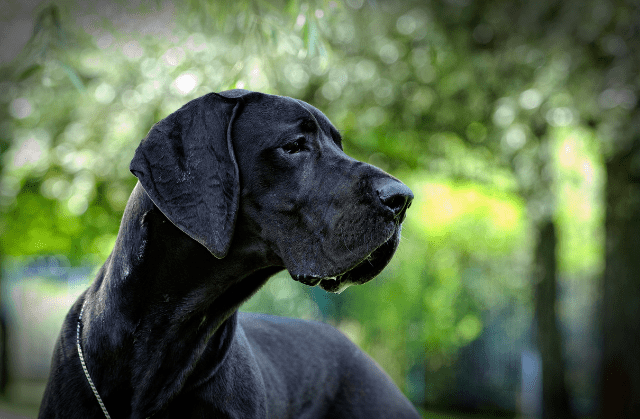
Many people consider Great Danes to be a scary dog breed – purely because of their size. That, combined with a fully black coat is a pretty impressive canine.
For a Great Dane to be considered black, it must have an entirely black coat, which means no markings on its chest or paws.
Because this Great Dane color is so impressive, these dogs are often used in shows because the wonderful coat shows off a Dane’s impressive body.
If you search around, however, you should be able to find one to adopt as your family pet.
Blue Great Dane
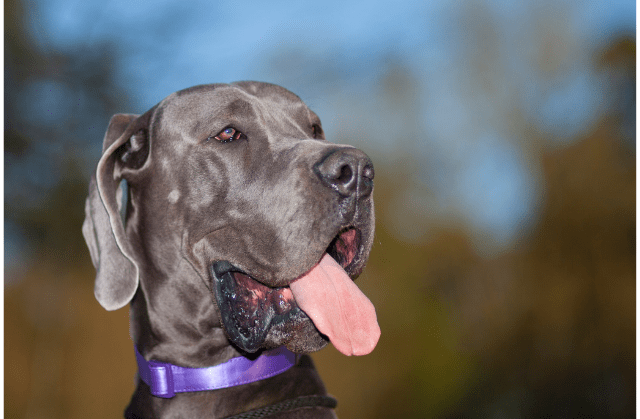
Blue is a very popular color for many breeds of dogs – including Great Danes! Blue Great Danes aren’t actually blue, but rather a beautiful gray which, in certain lights, can look a little blue.
Great Danes with a pure steel blue coat have a recessive gene that turns a black coat this beautiful color. Both parent dogs need to have the blue gene for them to have blue puppies.
These dogs can have a coat that’s a much darker shade of ‘blue’ or one that’s more silvery gray. The most popular is somewhere in the middle.
Brindle Great Dane

Brindle is another favorite coat color for many pooches, including this brindle Pitbull and, of course, the Great Dane!
Brindle Great Danes have a beautiful stripey coat. They often have a deep yellow-gold base coat (or fawn) and black or brown tiger stripes.
These doggos should have black eye rims and noses and they may have black patches on their ears and the tip of the tail.
Too much or too little brindle is undesirable and may result in your dog being disqualified.
Fawn Great Dane
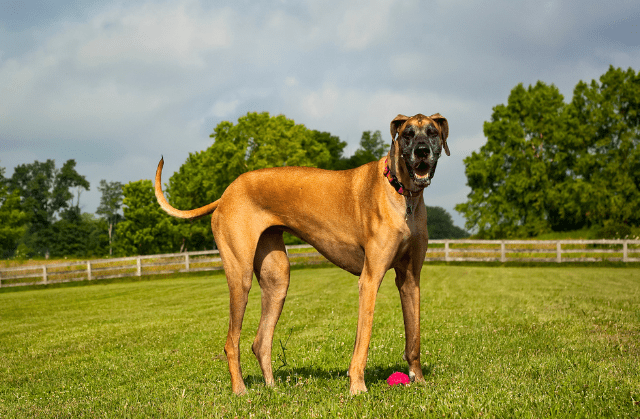
Fawn Great Danes are fairly common and another beauty! Whilst one of the most popular Great Dane colors, fawn pups are not actually that easy to breed.
Fawn is a recessive gene which means that both parents need to have this gene for them to have fawn puppies.
These doggos have a wonderful, rich yellow coat color and a black mask. They may also have black markings around their eyes and on the tip of their tail. White markings on the chest or toes are not desirable.
Check out some other dogs with yellow coats!
Harlequin Great Dane
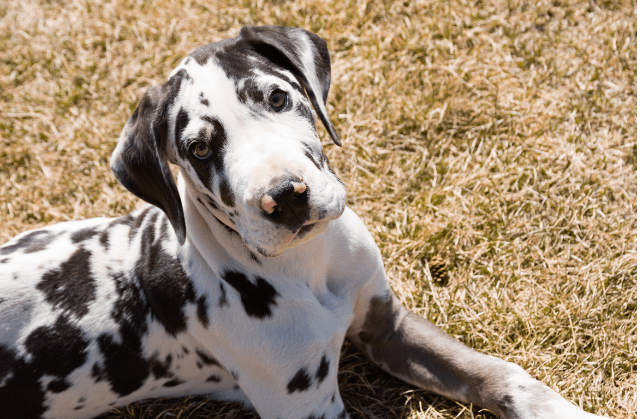
Harlequin Great Danes have a snow-white base coat with irregular patches of black all over their bodies. For competitions, a pure white neck is preferred.
The harlequin coat can also have merle patches. It’s also allowed, although less desirable, for a harlequin Great Dane to have patches of a salt and pepper coat, i.e. black hairs mixed in with the white base coat.
There are some health concerns associated with harlequin Great Danes and their predominately white coat. This can include congenital deafness.
It’s best to breed harlequin dogs with mantle dogs to get a harlequin puppy, rather than breeding two harlequins together.
Merle Great Dane

Merle Great Danes are especially attractive dogs. Similar to harlequin pups, they have a base coat color with patches and markings of other colors. They usually have a gray base coat color with patches of darker gray, black, and white.
Although merle Great Danes are perfectly healthy, you do have to be careful about breeding merle Great Dane puppies.
The merle gene is associated with eye color, so it’s therefore important not to breed two dogs together that have this gene. The result would be a double merle puppy that could suffer from a number of eye and ear problems.
It was only in 2018 that merle was added to the list of Great Dane coat colors. Check out our blog on merle dog breeds for more information about the gene and doggos with this beautiful coat.
Mantle Great Dane

Mantle is another variety of black and white. The main difference, however, is where the black and white fur is desired. Mantle Great Danes have a black blanket that covers their body, a black head and a white neck, collar, and muzzle.
They may have a white chest and white patches on their fore and hind legs. These striking pups may also have a white tail tip.
Until the 1990s, mantle Great Danes were referred to as Boston Great Danes because of their resemblance to the Boston Terrier.
Do Great Danes Change Color as They Grow Older?
Yes! It’s perfectly possible for your Great Dane’s coat color to change as they mature – so don’t register your pup into competitions before they’re one!
At this age, pups tend to lose their adorable, fluffy puppy fur and the harder hairs that grow in are often darker.
Great Danes usually have their adult coat by the age of 18 months.
Does Coat Color Affect The Dog’s Temperament?
No. Color shouldn’t affect the personality or temperament of your pup. The dog’s history, training, and early socialization are all much more important factors when it comes to how your dog will behave.
Great Danes will benefit from lots of socialization with other pups and people from a young age. They also need to engage their brains, so lots of fun training is a must.
If you have a pup that likes to chew, try getting them an indestructible dog toy to keep them entertained. You can even put their favorite treat inside and let them use their brain to get it out!
Although color won’t affect a dog’s temperament, there is such a thing as black dog syndrome. Generally speaking, many people feel intimidated around black dogs and therefore may be unwilling to approach them.
Of course, black dogs are wonderful and loving, but many end up in shelters because they’re not as desirable (we disagree)!
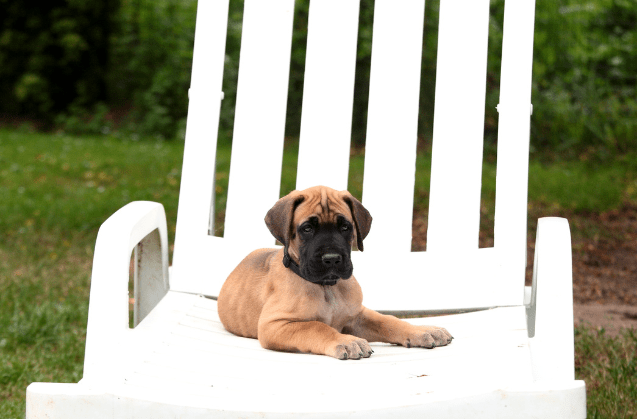
Does Coat Color Affect the Health of a Great Dane?
There are many perfectly healthy Great Dane coat colors. There are, however, a few that need special attention when it comes to possible health conditions.
It’s important that you don’t adopt a double merle Great Dane, so breeders should always be able to provide you with the correct checks to make sure your pup is healthy.
Similarly, there are some issues associated with a white-coated Great Dane. Harlequin pups and pure white Great Danes may suffer from a number of eye and ear-related health problems.
So, Which Out Of All The Great Dane Colors Is Right for You?
Great Danes are wonderful, big dogs. So before you get one of these based on their amazing coat colors, it’s important to think about whether you have the space and experience to take on 175 pounds of canine fun.
If you decide a Great Dane is for you, then making sure you get a healthy and happy pup from a respectable breeder is essential.
Some coats are associated with health problems, so do your research to make sure your breeder is reputable and is breeding for the health of the breed. Whichever Great Dane color you go for, you’re sure to get an amazing gentle giant that will be a huge part of the family!
